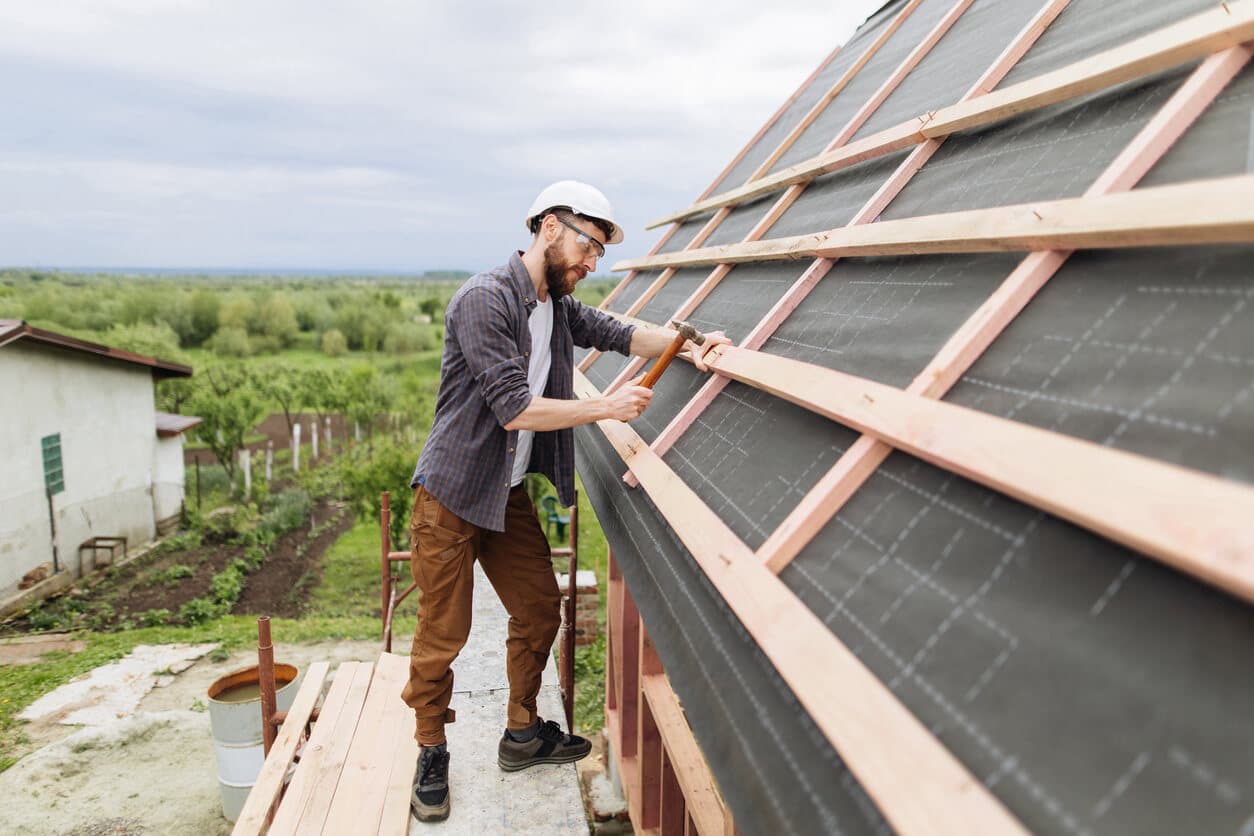
You noticed it one morning while sipping coffee by the window; a few cedar shakes curled at the edges, their once warm color faded to gray. Maybe it was last night’s storm, or maybe it’s been building for years. Either way, that creeping worry sets in. Is it just a minor issue or the beginning of something bigger?
As a homeowner, your roof isn’t just part of your house. It protects the memories inside, shields your investment, and quietly endures the weight of every season. But when signs of wear appear, it’s hard to know what to do. Should you repair it? Replace it entirely? And who can you really trust to give you an honest answer?
That’s where Mr. Roofer steps in. With years of specialized experience in cedar shake roofing and a repair-first philosophy built on integrity, Mr. Roofer brings clarity to what often feels like a confusing and costly decision. This guide will walk you through everything you need to know, from spotting signs of trouble to understanding costs and long-term value, and how to install cedar shake roof, so you can move forward with confidence, not guesswork.
When to Replace Cedar Shake Roof in Alpharetta
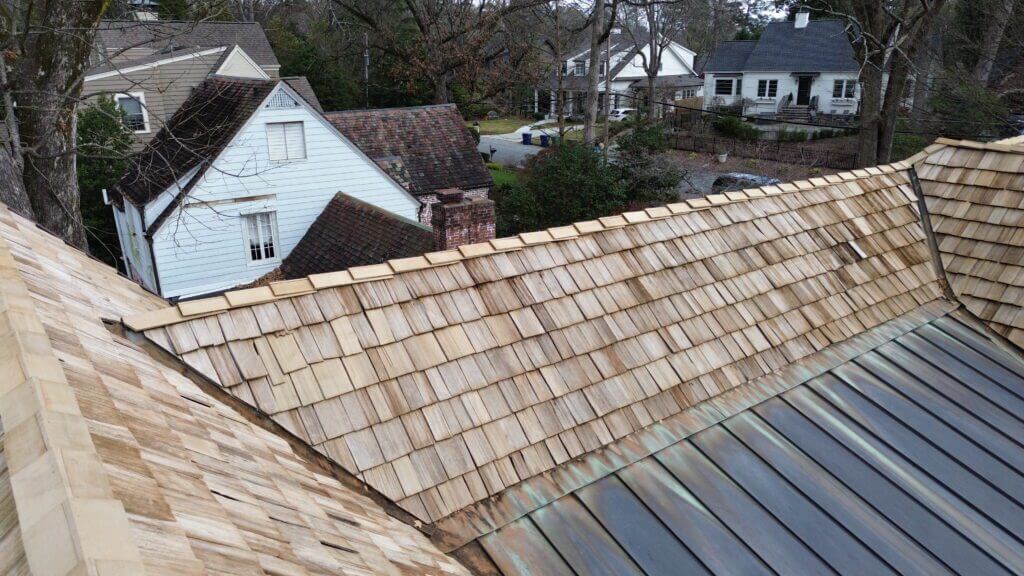
Even with the durability and charm of cedar shake, no roof lasts forever. Recognizing the signs of failure early can protect your home from costly structural damage and help you make an informed decision between repair and replacement. While it’s important to prioritize repair when possible, there are certain conditions where replacement is the safer and more cost-effective route. Below, we explore common red flags and how to tell when your cedar shake roof has reached the end of its service life.
Common Issues
Curling, cracking, and splitting shakes
As cedar shakes age, they begin to lose their natural oils and moisture resistance. This can lead to:
- Visible curling at the edges
- Surface cracking
- Deep splits through the wood
While a few damaged shakes can be replaced individually, extensive cracking and curling across multiple slopes of the roof typically point to systemic failure. At this stage, repairing individual shakes becomes less practical, and a full replacement may be the most reliable option to preserve the roof’s integrity.
Moss or algae buildup
Cedar is a natural material, which makes it especially prone to organic growth in damp or shaded environments. Moss and algae may seem like just a cosmetic problem, but they retain moisture against the wood, accelerating rot and decay. If the infestation is widespread and the shakes are soft or spongy to the touch, it’s a strong indicator that moisture has penetrated beyond the surface. When moss growth compromises ventilation or structural performance, replacing the roof may be the only way to restore a healthy roofing system.
Leaks near chimneys, valleys, or flashing
Persistent leaks around vulnerable areas like chimneys, valleys, or flashing points often signal deeper problems. If the underlayment is deteriorated or the shakes around these penetrations are warped or decaying, water can easily find its way inside. Localized cedar shake roof repairs may provide temporary relief, but if these leaks are recurring despite patchwork fixes, it’s often a sign that the entire system is aging out of its protective capabilities. In such cases, replacement ensures that both the cedar shakes and the underlayment are fully restored.
How to Tell if a Cedar Shake Roof is Bad
Visible daylight in the attic
One of the clearest signs that a cedar shake roof is failing is seeing beams of daylight coming through the roof boards into the attic. This typically means that the shakes or the sheathing underneath have gaps, cracks, or have shifted out of place. While one or two visible spots might be sealed, multiple penetrations almost always indicate a compromised roof envelope that needs full replacement.
Moldy or sagging decking
If the decking beneath the cedar shakes becomes soft, warped, or saggy, it’s likely the result of prolonged moisture intrusion. Mold, mildew, or the musty smell of rot are strong indicators that water has infiltrated past the outer layer. Once the roof deck begins to degrade, replacing individual shakes will no longer stop the deterioration. In this case, structural replacement is required to prevent further damage to the attic, insulation, and interior ceilings.
Widespread granule loss or wood rot
Cedar shakes gradually wear down over time, losing their protective surface texture. When large areas show signs of erosion, splintering, or softness from rot, it compromises the roof’s ability to shed water and resist wind. Unlike asphalt shingles that shed granules, cedar wears in layers, and by the time rot is visible on the surface, much of the material’s strength is already gone. If deterioration is present across multiple slopes or elevations, replacing the entire roof may be necessary for long-term protection.
Cedar Roof Installation Process in Alpharetta
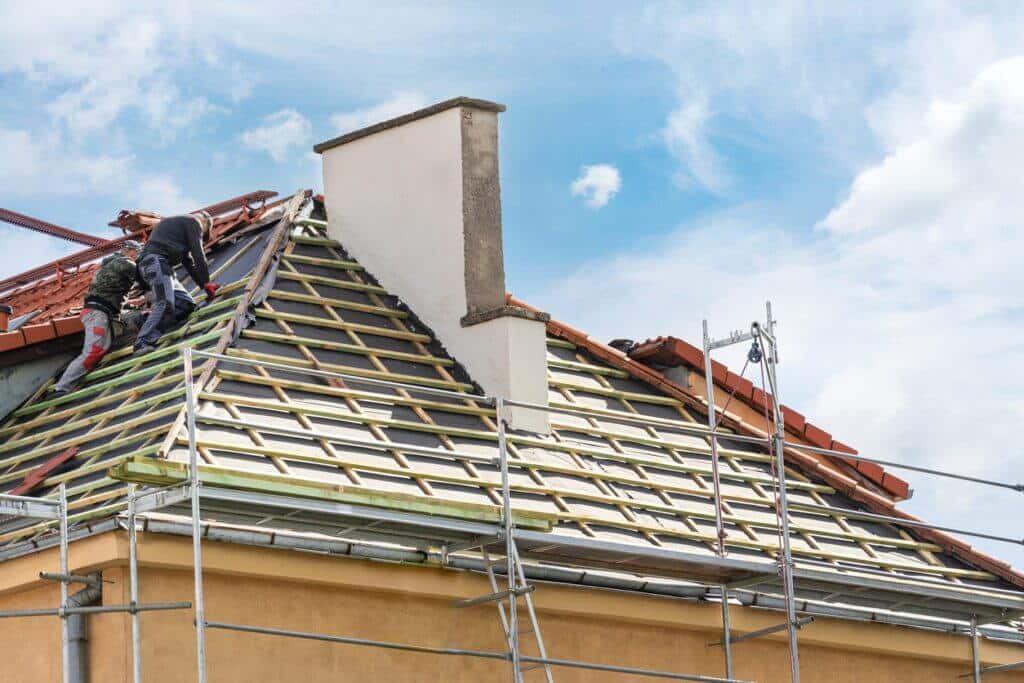
Installing a cedar shake roof is a highly specialized process that requires expert craftsmanship, especially to ensure durability and weather resistance in Georgia’s climate. Every step, from tear-off to final inspection, must be performed with precision to maintain the performance and aesthetic appeal of this premium roofing system. Here’s what you can expect during a typical cedar roof installation.
Step-by-step breakdown
1. Tear-off (If Applicable)
The process begins by removing the existing roofing materials, including old shakes or shingles and any worn-out underlayment. This step is crucial for identifying any hidden damage to the structure below. A complete tear-off also allows the new cedar shakes to lay flat and seal properly, improving the roof’s long-term performance. In some rare cases where a second layer is permissible, Mr. Roofer evaluates the structural load-bearing capacity before proceeding. However, a full tear-off is usually recommended for cedar to ensure breathability and proper ventilation.
2. Inspection of Decking and Underlayment
Once the roof is stripped down to the decking, a detailed inspection is performed to identify any signs of:
- Rot
- Mold
- Sagging
- Structural weakness
This is a critical phase because any damage here can undermine the entire roof system. If necessary, the decking is repaired or replaced with sturdy, properly spaced sheathing that allows the cedar shakes to breathe. Mr. Roofer pays special attention to the pitch and drainage angles, ensuring water will shed away efficiently.
3. Installation of Felt Underlayment or Synthetic Barrier
Next, a breathable yet water-resistant layer is installed over the decking. Traditionally, heavy roofing felt was the material of choice, but modern cedar shake roof installations may opt for high-performance synthetic underlayments that resist moisture while allowing vapor to escape. This barrier prevents moisture buildup beneath the cedar shakes while also protecting the decking during heavy rain or wind events. Proper overlap and fastening techniques are used to avoid water intrusion at seams or valleys.
4. Starter Row and Proper Shake Spacing
The first course of shakes, known as the starter row, sets the foundation for the entire cedar shake roof installation. Each shake is carefully aligned and spaced to allow for natural expansion and contraction while promoting even water runoff. Attention is paid to staggering joints between rows, which helps reduce the risk of leaks. Ensure that the shakes are elevated slightly off the underlayment using felt interlays or spacers, allowing airflow beneath and preventing premature rot. Consistent spacing also ensures a refined appearance that maintains its symmetry over time.
5. Nail Pattern and Ventilation Considerations
Cedar shakes require a specific nailing pattern to secure each piece without splitting the wood or restricting movement. Typically, stainless steel or hot-dipped galvanized nails are used to prevent rust and staining. The nails must be positioned precisely to anchor each shake securely without overdriving. Just as important is ventilation. Incorporate ridge vents, soffit vents, and breathable underlayments to allow heat and moisture to escape from the attic. Proper airflow extends the life of the roof and supports energy efficiency within the home.
6. Building Code Considerations in Georgia
Atlanta and Georgia have specific building codes and climate considerations that must be addressed during cedar shake installation. These include fire-resistance ratings, wind uplift standards, and ventilation requirements for humid conditions. For example, some areas may require fire-treated cedar shakes or a Class C roofing system to comply with local codes. Ensure full compliance by:
- Securing the proper permits
- Adhering to spacing and fastening guidelines
- Incorporating all mandated safety measures
This ensures that the roof not only performs well but also passes final inspection without delay.
Cost Considerations for Cedar Roof Installation in Alpharetta
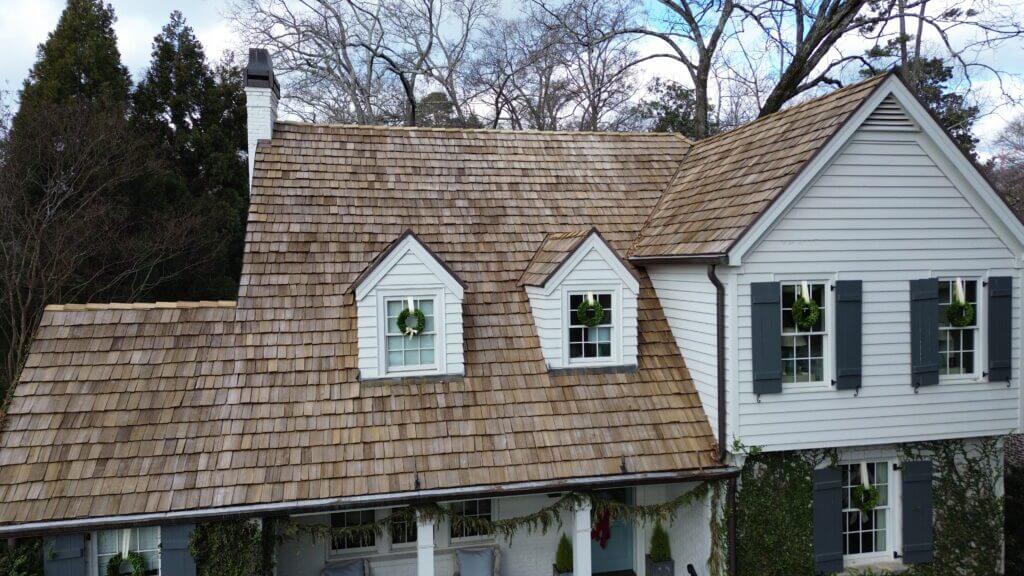
Cedar shake roofs are a premium roofing option, known for their beauty, longevity, and natural insulation properties. However, these benefits come with a higher upfront investment than asphalt or composite alternatives. Understanding the financial aspects of installing a cedar shake roof is essential for homeowners considering this upgrade.
Several variables influence the final cost, including roof size, pitch, tear-off needs, material grade, underlayment type, and local building codes. Labor also represents a significant portion of the cost, given the technical skill required to properly install cedar shakes to ensure long-term performance in Georgia’s climate.
Average Cedar Shake Roof Installation Costs in Atlanta (Summary table)
The table below provides a general estimate of what homeowners in the Atlanta area can expect when installing a new cedar shake roof. Please note that these figures are averages, and actual pricing may vary depending on the unique characteristics of your home, material selections, and site conditions.
Cost Component | Estimated Range (Per Square Foot) | Notes |
Cedar Shakes (Materials Only) | $6 – $10 | Depends on shake grade (perfection, premium, or hand-split) |
Underlayment (Felt or Synthetic) | $1 – $2 | Higher cost for breathable synthetic options |
Labor and Installation | $6 – $12 | Skilled craftsmanship drives this cost; steeper roofs may cost more |
Tear-Off and Disposal (if applicable) | $1 – $3 | Varies based on layers and ease of removal |
Flashing, Vents, and Extras | $1 – $2 | Includes chimney flashing, ridge vents, and custom details |
Permits and Inspection Fees | $0.50 – $1 | Based on local regulations in Atlanta and Georgia |
Total Installed Cost | $15 – $30 per sq ft | Equivalent to $15,000 – $30,000 for a 1,000 sq ft roofing system |
These figures are meant to serve as a general guide. Custom features such as copper flashing, fire-treated shakes, or complex rooflines can increase total costs. Mr. Roofer conducts thorough on-site evaluations to provide tailored quotes that reflect both your design preferences and structural needs.
If you are looking for an accurate estimate tailored to your home, Mr. Roofer offers complimentary consultations that include a full inspection and itemized proposal. This ensures that every client receives honest pricing and expert guidance before making a major investment.
Variables That Affect Price
1. Roof Size and Pitch
Larger roofs naturally require more materials and labor, increasing overall project costs. However, the pitch or steepness of your roof can also play a significant role. Steeper roofs are more labor-intensive and may require specialized equipment and safety harnesses. Additionally, steep pitches reduce walkability, slowing down cedar shake roof installation and increasing labor hours. Even a moderately sized roof with a complex pitch can cost more than a larger, flatter one.
2. Shake Type and Grade
Not all cedar shakes are created equal. Options range from perfection-grade shakes, which are sawn on both sides for a uniform appearance, to hand-split and resawn shakes that offer a more rustic, textured look. Premium grades come with fewer imperfections and greater thickness, which extends the lifespan but also increases the price. Homeowners should also consider whether they want pressure-treated or fire-treated shakes, which are often required by code in certain areas and come at a higher cost.
3. Labor and Permitting
Cedar roof shingles installation is a labor-intensive craft that demands expert-level precision. Inexperienced installers can void warranties or leave the home vulnerable to moisture damage. Quality labor is therefore one of the highest cost drivers, but also one of the most important for long-term performance. Additionally, permitting fees in Atlanta and Georgia can vary across municipalities like Alpharetta. Factors like inspection requirements, local building codes, and historical preservation rules can affect both timing and budget.
4. Repair vs. Full Replacement
In many cases, especially with Mr. Roofer’s repair-first philosophy, homeowners may not need a full replacement. Spot repairs, partial re-roofing, or reinforcement of problem areas can cost significantly less than replacing the entire system. However, if widespread damage, rot, or underlayment failure is present, piecemeal repairs could become more costly in the long run. An honest roof assessment will help determine the most cost-effective and protective course of action.
5. Financing Options or Phased Repairs
For homeowners concerned about upfront costs, financing can be a valuable tool. Mr. Roofer can help clients explore payment plans or staged cedar shingle repairs to ease the financial burden. In some cases, a phased approach, such as replacing one roof slope at a time, can help homeowners extend the timeline of investment without compromising safety. These options make premium roofing more accessible while preserving the home’s integrity.
6. Long-Term Value vs. Upfront Cost
While cedar shake roofing requires a higher initial investment, it delivers significant long-term value. Its natural insulating properties can reduce heating and cooling costs, and its curb appeal can boost property value. A properly installed cedar roof can last 30 to 50 years or more, depending on maintenance and weather conditions. When viewed as a long-term investment, many homeowners find the return in durability, beauty, and reduced maintenance far outweighs the upfront expense.
Cedar Shake Roof Repair vs. Replacement in Alpharetta
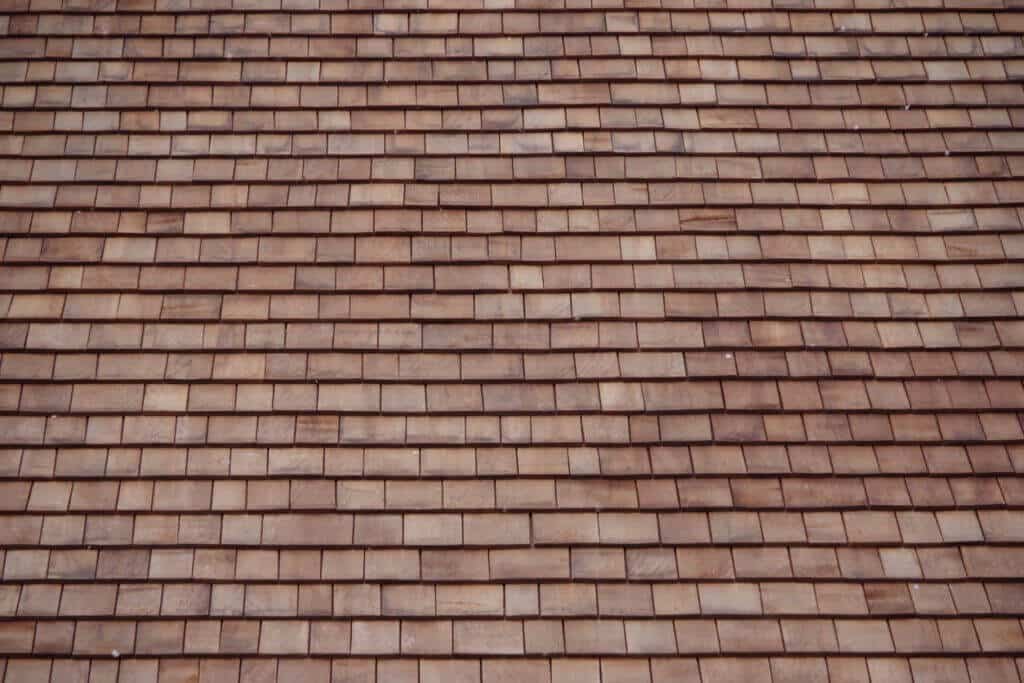
For homeowners with cedar shake roofing, deciding whether to repair or fully replace the system is a critical financial and structural decision. The goal is always to preserve as much of the original roof as possible while ensuring long-term performance and protection. Understanding when a targeted cedar shingle repair is sufficient and when a full replacement is the wiser investment can help you make a confident, informed choice.
When Localized Repairs Are Viable
In many cases, a cedar shake roof can continue to perform well with minor, precise repairs. The key is catching problems early, before they spread and compromise the surrounding materials or roof deck.
Small Leak Areas
Leaks that appear in isolated spots, often near a chimney, vent, or flashing, can frequently be resolved without full replacement. These are typically caused by minor flashing deterioration or a few damaged shakes. Mr. Roofer’s experienced team will:
- Remove affected shakes
- Inspect the underlayment
- Replace any compromised layers
- Install new shakes to match the existing ones
This approach saves money and avoids disrupting the entire roof structure.
Missing or Broken Shakes
Over time, a few shakes may split, curl, or be blown off during a storm. If the damage is contained to a limited section and the underlayment beneath is intact, individual shake replacement is a simple and cost-effective solution. Matching the grain, color, and size is key to ensuring visual cohesion. Mr. Roofer specializes in seamless cedar shake roof repairs that maintain both the function and appearance of the roof without resorting to premature replacement.
When Full Replacement Is More Cost-Effective
There comes a point where repeated cedar shingle repairs become more costly and less effective than starting fresh. Understanding these tipping points can help homeowners avoid sinking funds into a failing system.
Recurrent Leaks
If leaks return after previous cedar shake roof repairs or if multiple leaks appear across different parts of the roof, this usually signals deeper issues. Water may be finding its way through the underlayment or compromised areas that are not immediately visible from the surface. At this stage, patching isolated areas becomes a short-term fix, not a long-term solution. Full replacement ensures all vulnerable components are addressed at once, restoring full waterproofing and structural reliability.
Decking or Underlayment Issues
Cedar shake roofs rely on breathable, well-maintained underlayment and sound decking to perform effectively. If moisture has penetrated and caused the deck to sag, rot, or mold, simply replacing the top layer of shakes will not solve the underlying issue. Similarly, deteriorated or improperly installed underlayment can lead to chronic moisture problems, even if the shakes above appear intact. In these cases, replacement is necessary to protect the home’s structure and ensure compliance with local building standards.
Cedar Shake Roof Repair vs. Replacement: Comparison Table
Here’s a table to help you visually understand the trade-offs between cedar shingle repair and full replacement:
Feature / Factor | Repair | Full Replacement |
Cost | Lower upfront cost | Higher initial investment |
Scope of Work | Targets specific problem areas | Addresses entire roof system |
Time to Complete | Typically 1-3 days | Typically 1-2 weeks |
Disruption to Home | Minimal | Moderate (especially with tear-off) |
Ideal For | Isolated leaks or missing shakes | Widespread damage, aged or failing systems |
Lifespan Gained | 1-5 years (depending on condition) | 30-50 years (with proper maintenance) |
Structural Upgrades | Limited to affected areas | Full decking, underlayment, and ventilation review |
Visual Consistency | May be slightly noticeable in patched areas | Entire roof has uniform, refreshed appearance |
Risk of Future Issues | Higher if underlying problems persist | Lower due to full system reset |
Return on Investment | Moderate | High (especially for resale or long-term plans) |
Importance of Professional Inspection Before Deciding
Making the right decision between cedar shake roof repair and replacement requires a comprehensive inspection by a cedar roofing specialist. What may look like surface-level damage could be a symptom of deeper structural issues, while some seemingly large areas of damage may still be eligible for focused repairs. Mr. Roofer’s inspection process includes a detailed evaluation of
- Shakes
- Underlayment
- Flashing
- Ventilation
- Roof decking
Every recommendation is backed by photographic evidence, material expertise, and a repair-first mindset aimed at saving you money without compromising protection.
For homeowners who value long-term reliability and expert guidance, trusting a professional evaluation ensures that the decision to repair or replace is based on facts, not fear.
Maintenance Tips to Prolong Lifespan
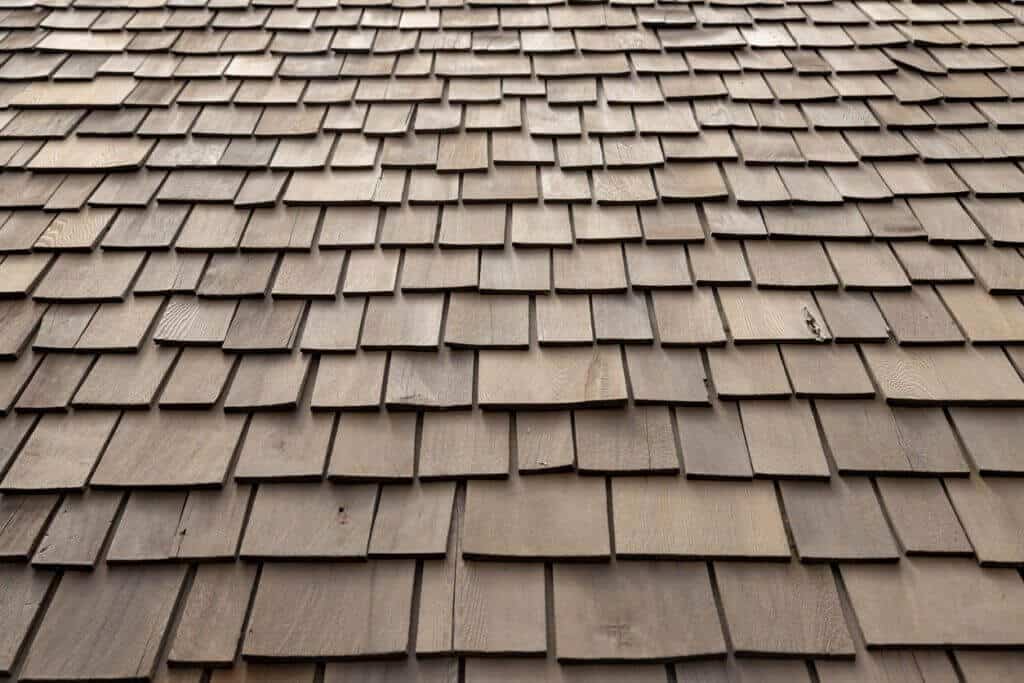
Cedar shake roofs offer unmatched natural beauty and exceptional performance, but they require consistent care to live up to their full potential. Proper maintenance can significantly extend the life of your roof, preserve its aesthetic appeal, and prevent premature failure due to neglect. For homeowners who invest in cedar, staying proactive with upkeep is not just recommended but essential. The following best practices will help ensure your roof remains strong, attractive, and functional for decades.
Routine Inspections (Annual + After Storms)
One of the most effective ways to protect a cedar shake roof is through regular inspections. At a minimum, an annual inspection should be scheduled to assess the condition of the shakes, flashing, ventilation, and underlayment. In Atlanta, Georgia’s climate, where heavy rain and windstorms are common, it’s also wise to have the roof checked after major weather events. Early detection of issues like loose shakes, small leaks, or blocked vents allows for quick, targeted cedar shake roof repairs before they evolve into more serious and costly problems.
Professional roofers are trained to spot subtle signs of wear that may not be visible from the ground or obvious to the untrained eye. A routine inspection provides peace of mind and serves as a preventive measure that safeguards your investment year after year.
Moss and Algae Control
Cedar’s organic makeup makes it vulnerable to moss, algae, and mildew, especially in shaded or humid environments. These growths may appear harmless at first, but can retain moisture against the shakes, leading to premature rot, warping, and surface degradation. Controlling biological growth is vital to maintaining the integrity of the roof system.
Safe, non-abrasive treatments are available to kill moss and algae without damaging the wood. These may include gentle chemical washes or natural treatments applied by hand. Ensures all cleaning products used are compatible with cedar and environmentally conscious. Regular control treatments, especially during humid seasons, can preserve both performance and curb appeal.
Debris Removal and Gutter Cleaning
Leaves, twigs, and other debris often accumulate on cedar shake roofs and in gutters, especially if trees overhang the structure. Allowing debris to sit on the roof traps moisture and creates an environment where mold, moss, and decay thrive. Blocked gutters can also cause water to back up under the shakes, leading to leaks and structural damage.
Seasonal cleaning, particularly in fall and spring, helps prevent these issues. Removing debris from the roof surface and ensuring gutters and downspouts are clear allows for proper drainage and airflow, two essential elements for cedar shake longevity. In some cases, trimming nearby branches may also be recommended to reduce leaf buildup and minimize abrasion from limbs during storms.
Spot Treatment and Sealants (If Applicable)
While traditional cedar shake roofs are designed to breathe and weather naturally, some homeowners may choose to use approved sealants or preservatives to enhance longevity. These treatments can provide added resistance against UV degradation, moisture, and fungal growth.
Not all sealants are suitable for cedar, and over-application can trap moisture instead of allowing it to escape. Therefore, any application should be done selectively, using breathable products recommended by professionals. Spot treatments are sometimes applied to shakes in high-moisture zones, such as roof valleys or shaded slopes, to reinforce durability where it’s most needed.
Mr. Roofer advises only using treatments when necessary and always under professional guidance to avoid compromising the natural performance of cedar.
Importance of Having a Local Expert Like Mr. Roofer Monitor the System
Cedar shake roofs require a level of attention and understanding that goes beyond general roofing knowledge. With Georgia’s unique weather patterns, humidity levels, and code requirements, having a local expert is invaluable.
Mr. Roofer brings years of specialized cedar roofing experience and a deep understanding of regional challenges. Ongoing maintenance programs can be tailored to your home, including:
- Scheduled inspections
- Timely repairs
- Personalized advice on care techniques
Having a trusted expert regularly monitor your roof ensures that small issues are addressed early and that your investment continues to perform at its best.
For homeowners who value both beauty and longevity, enlisting a seasoned local partner like Mr. Roofer is one of the smartest steps toward preserving a cedar shake roof for decades to come.
Conclusion: Invest Wisely in Your Cedar Shake Roof
A cedar shake roof is more than just a beautiful feature of your home. It’s a long-term investment in comfort, performance, and curb appeal. But like any high-value asset, it requires expert care, timely maintenance, and a trusted partner who knows when to repair and when to recommend replacement.
From understanding common issues to weighing costs and navigating the cedar shake roof installation process, making the right decisions starts with having the right information and the right roofer. Mr. Roofer brings a rare combination of craftsmanship, honesty, and deep cedar expertise to every project. Whether you need a small repair, a full replacement, or just a professional opinion for your home in Alpharetta, you can count on a repair-first philosophy grounded in integrity and precision.
Protect your home with the knowledge and service it deserves. Contact Mr. Roofer today to schedule a complimentary cedar shake roof inspection and take the first step toward lasting peace of mind.
